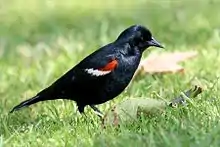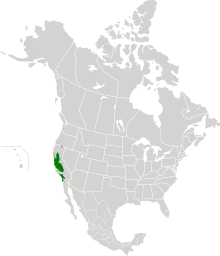Tricolored blackbird
The tricolored blackbird (Agelaius tricolor) is a passerine bird of the family Icteridae. Its range is limited to the coastal areas of the Pacific coast of North America, from Northern California in the U.S. (with occasional strays into Oregon), to upper Baja California in Mexico.
| Tricolored blackbird | |
|---|---|
 | |
| A male tricolored blackbird in California, United States | |
| Scientific classification | |
| Kingdom: | Animalia |
| Phylum: | Chordata |
| Class: | Aves |
| Order: | Passeriformes |
| Family: | Icteridae |
| Genus: | Agelaius |
| Species: | A. tricolor |
| Binomial name | |
| Agelaius tricolor (Audubon, 1837) | |
 | |
| range of Tricolored blackbird | |
This highly social and gregarious bird forms the largest colonies of any North American landbird, with a single breeding colony often consisting of tens of thousands of birds.
The common name is taken from the male bird's distinctive white stripes on bottom of their red shoulder patches, or "epaulets", which are visible when the bird is flying or displaying.
Despite the similar names, this bird is not related to the Old World common blackbird, which is a thrush (Turdidae).
The species' call sounds slightly more nasal than that of the red-wing's - a nasal kip and a sharp check. The male's song is a garbled on-ke-kaaangh. The bird migrates south during the colder seasons to Mexico and back to northern California during the warmer seasons.
Endangered status
In 1990 the Department of Fish and Game (DFG) of California, based on significant decline in population numbers documented in the 1980s, added the tricolored blackbird to the published list of "Bird Species of Special Concern". This classification is an "administrative designation intended to alert biologists, land managers and others to a species declining status and encourages them to provide additional management considerations". At this time the tricolored was added to the U.S. Fish and Wildlife Service (USFWS) list of Birds of Conservation Concern.

By 1991, the tricolor blackbird's breeding population had fallen to approximately thirty-five thousand adults. This prompted a petition submitted by the Yolo chapter of the National Audubon Society to the California Fish and Game Commission. The petition brought the tricolored blackbird under consideration for endangered classification. The classification was granted until the breeding season in 1992. It was then that researchers discovered a population exceeding three hundred thousand adults. A petition to withdraw the endangered classification was submitted and accepted. Conservation measures were supposed to be developed and implemented to avoid a future decline as seen before. These measures were developed, but only very limited progress was made in preventing the future decline of the tricolored blackbird. Interested groups started reconvening shortly after the year 2000. Managing groups found startling results when conducting population research.[2]
In 2006 the tricolored blackbird was classified as Endangered by BirdLife International. Like the extinct passenger pigeon, the colonial nature of the tricolored blackbird makes it particularly vulnerable to extinction. Native grasslands once used for nesting and feeding have been lost to urban and agricultural development. Birds adapted to nesting in agricultural fields have been disturbed by harvesting during the breeding season. Once the tricolored blackbird was placed on the BirdLife Endangered Species list, it officially became a concern both regionally and nationally.
The U.S. Fish and Wildlife Service maintained the following "Primary conservation priorities for Tricolor habitat conservation and management" (The Tricolored Blackbird Working Group, 2007):
- Maintain, enhance, and protect existing habitat suitable for nesting, foraging, and wintering activities;
- Create and restore additional protected breeding habitats to support nesting and foraging;
- Identify mechanisms for protecting nesting and foraging habitats;
- To the extent allowable by law, survey private lands and identify largest and most vulnerable colonies;
- Encourage private landowners to protect active breeding colonies; and
- Encourage and enhance active breeding colonies on public lands.
References
- BirdLife International (2012). "Agelaius tricolor". IUCN Red List of Threatened Species. 2012. Retrieved 26 November 2013.CS1 maint: ref=harv (link)
- Weiland, Paul (June 12, 2015). "California Fish and Game Commission Votes Not to Make Tricolored Blackbird Candidate for Listing". Endangered Species Law & Policy. Los Angeles: Nossaman LLP.
Further reading
Book
- Beedy, E. C., and W. J. Hamilton III. 1999. Tricolored Blackbird (Agelaius tricolor). In The Birds of North America, No. 423 (A. Poole and F. Gill, eds.). The Birds of North America, Inc., Philadelphia, PA.
Thesis
- Orians GH. Ph.D. (1961). The Ecology of Social Systems in the Red-Winged Blackbird (Agelaius phoeniceus) and the Tricolored Blackbird (Agelaius tricolor). University of California, Berkeley, United States—California.
Articles
- (2003). Emergency protection sought for tricolored blackbird. J Wildl Rehabil. vol 26, no 3. p. 36-36.
- Academy of Natural Sciences of P. (1999). Tricolored blackbird: Agelaius tricolor. Birds of North America. vol 0, no 423. p. 1-23.
- Cook LF & Toft CA. (2005). Dynamics of extinction: population decline in the colonially nesting Tricolored Blackbird Agelaius tricolor. Bird Conservation International. vol 15, no 1. p. 73-88.
- Crase FT & De Haven RW. (1977). Food of Nestling Tricolored Blackbirds. Condor. vol 79, no 2. p. 265-269.
- Crase FT & Dehaven RW. (1976). Selected Bibliography on the Food Habits of North American Blackbirds. U S Fish & Wildlife Service Special Scientific Report Wildlife. vol 192, p. 1-20.
- Crase FT & Dehaven RW. (1978). Food Selection by 5 Sympatric California USA Blackbird Species. California Fish & Game. vol 64, no 4. p. 255-267.
- De Haven RW, Crase FT & Woronecki PP. (1975). Movements of Tricolored Blackbirds Banded in the Central Valley of California 1965-1972. Bird Banding. vol 46, no 3. p. 220-229.
- Dehaven RW, Crase FT & Miller MR. (1974). Aging Tri Colored Blackbirds by Cranial Ossification. Bird Banding. vol 45, no 2. p. 156-159.
- Dehaven RW, Crase FT & Woronecki PP. (1975). Breeding Status of Tricolored Blackbird, 1969-1972. Calif Fish Game. vol 61, no 4. p. 166-180.
- Emlen JT. (1985). Morphological Correlates of Synchronized Nesting in Tricolored Blackbird Agelaius-Tricolor Colony. Auk. vol 102, no 4. p. 882-884.
- Hamilton WJ, III. (1998). Tricolored blackbird itinerant breeding in California. Condor. vol 100, no 2. p. 218-226.
- Holcomb LC. (1971). Nest Building and Egg Laying by Redwinged Blackbirds in Response to Artificial Manipulations. Auk. vol 88, no 1. p. 30-34.
- Kobayashi H. (1975). Absorption of Cerebro Spinal Fluid by Ependymal Cells of the Median Eminence. In Knigge, K M et al. (Ed) Brain-Endocrine Interaction Ii the Ventricular System in Neuroendocrine Mechanisms Symposium. Shizuoka, Japan Oct 16-18, 1974 Ix+406p Illus S Karger: Basel, Switzerland; New York, NY, USA ISBN 3-8055-2176-6, p. 109-122, 1975.
- Oota Y, Kobayashi H, Nishioka RS & Bern HA. (1974). Relationship between Neuro Secretory Axon and Ependymal Terminals on Capillary Walls in the Median Eminence of Several Vertebrates. Neuroendocrinology. vol 16, no 2. p. 127-136.
- Palmer TK. (1976). Pest Bird Damage Control in Cattle Feedlots the Integrated Systems Approach. Proceedings of the Vertebrate Pest Conference. vol 7, p. 17-21.
- Payne RB & Landolt M. (1970). Thyroid Histology of Tricolored Blackbirds Agelaius-Tricolor in the Annual Cycle Breeding and Molt. Condor. vol 72, no 4. p. 445-451.
- Powell Gun. (1974). Experimental Analysis of the Social Value of Flocking by Starlings Sturnus-Vulgaris in Relation to Predation and Foraging. Animal Behaviour. vol 22, no 2. p. 501-505.
- Rains MC, Mount JE & Larsen EW. (2004). Simulated changes in shallow groundwater and vegetation distributions under different reservoir operations scenarios. Ecol Appl. vol 14, no 1. p. 192-207.
- Schafer EWJ & Brunton RB. (1971). Chemicals as Bird Repellents 2 Promising Agents. Journal of Wildlife Management. vol 35, no 3. p. 569-572.
- Skorupa JP, Hothem RL & Dehaven RW. (1980). Foods of Breeding Tri Colored Blackbirds Agelaius-Tricolor in Agricultural Areas of Merced County California USA. Condor. vol 82, no 4. p. 465-467.
- Unitt P. (2004). Effect of plumage wear on the identification of female Red-winged and Tricolored Blackbirds. Western Birds. vol 35, no 4. p. 228-230.
- Vickers ML & Hanson RP. (1980). Experimental Infection and Serologic Survey for Selected Paramyxoviruses in Red-Winged Blackbirds Agelaius-Phoeniceus. Journal of Wildlife Diseases. vol 16, no 1. p. 125-130.
- http://www.fws.gov/migratorybirds/CurrentBirdIssues/Management/FocalSpecies/Plans/TCBL.pdf
External links
- Tricolored Blackbird Portal - Information Center for the Environment, UCDavis
- Tricolored blackbird photo gallery VIREO
- "Agelaius tricolor". Integrated Taxonomic Information System. Retrieved 24 February 2009.
